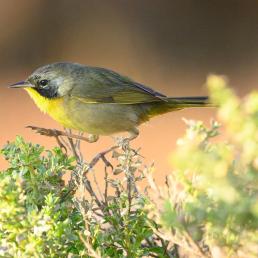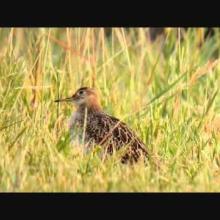

Join BirdNote tomorrow, November 30th!
Illustrator David Sibley and actor H. Jon Benjamin will face off in the bird illustration battle of the century during BirdNote's Year-end Celebration and Auction!
Upland Sandpipers are an emblematic bird of grassland habitats in many regions of the Americas. These shorebirds live far from sea with the largest breeding populations in the north central U.S. But Upland Sandpipers are losing breeding ground to row-crop agriculture, pushing some birds to nest at airports as a substitute for natural prairies. Preserving grasslands throughout their range will help ensure that the Upland Sandpiper’s signature whistling song continues to ring out.
This episode is sponsored in memoriam of Alice Ashbaugh, a lifelong birdwatcher and amateur ornithologist.
BirdNote®
Upland Sandpipers Whistling from Fences
Written by Conor Gearin
This is BirdNote.
[Upland Sandpiper call, ML516735, 0:29-0:30]
Upland Sandpipers cut a strange figure when they’re perched on a fence. They’re slender shorebirds that live far from the shore, and have tiny heads on long necks. Their song is a whistle that rises and falls.
[Upland Sandpiper song, ML516735, 1:00-1:03]
Upland Sandpipers need large areas of grassland habitat for their breeding grounds. In the eastern U.S. where prairies are sparse, they’ll sometimes nest at a rural airport — recognizing the expanse of grass beyond the tarmac as a place they can raise their young.
The largest breeding populations of Upland Sandpipers are in the north central U.S., where they’re still able to find grasslands without too many trees or bare ground. Loss of these habitats to row-crop agriculture and shrubby plants invading prairies has caused their numbers to plummet over the past century.
[Upland Sandpiper calls, ML50249, 0:30-0:32]
Upland Sandpipers take wing to South America for the winter, where the grasslands of Argentina, Uruguay, and Brazil provide a similar habitat as the prairies they left behind. Preserving grasslands throughout their range will help ensure that the Upland Sandpiper’s song continues to ring out.
[Upland Sandpiper song, ML50249, 1:01-1:04]
For BirdNote, I’m Michael Stein.
This episode is sponsored in memoriam of Alice Ashbaugh, a lifelong birdwatcher and amateur ornithologist.
###
Senior Producer: Mark Bramhill
Producer: Sam Johnson
Managing Editor: Jazzi Johnson
Content Director: Jonese Franklin
Bird sounds provided by The Macaulay Library of Natural Sounds at the Cornell Lab of Ornithology, Ithaca, New York. Upland Sandpiper ML50249 recorded by Geoffrey A. Keller. Upland Sandpiper ML516735 recorded by Wil Hershberger.
BirdNote’s theme was composed and played by Nancy Rumbel and John Kessler.
© 2025 BirdNote February 2025
Narrator: Michael Stein
ID# UPSA-01-2025-02-24 UPSA-01




